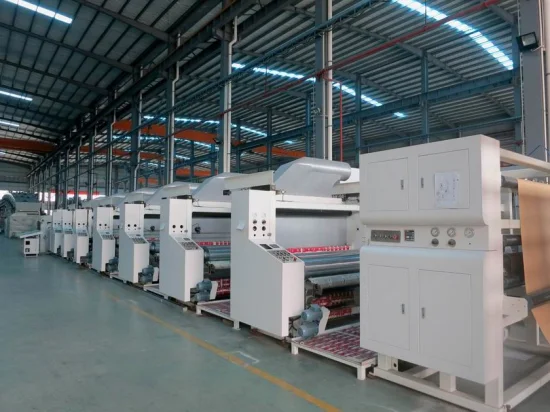Can a unit-type flexo press be integrated into a larger printing workflow?
Yes, a unit-type flexo press can be integrated into a larger printing workflow, providing many advantages over other printing methods. In this article, we will explore the basic definition and product features of the unit-type flexo press, its advantages, working principle, applications, selection criteria, potential problems and solutions, installation and maintenance, and company introduction.
What is a unit-type flexo press?
A unit-type flexo press is a type of printing press used in the flexographic printing process. It is designed with modular units that can be combined and configured according to specific printing requirements. Each unit of the press consists of various components, such as a plate cylinder, anilox roller, inking system, and impression cylinder, which work together to transfer ink onto the printing substrate.

Advantages of a unit-type flexo press
- Versatility: Unit-type flexo presses offer great flexibility and versatility in printing applications.
- High Printing Quality: Flexo presses have made significant advancements in recent years, achieving excellent print quality comparable to other printing methods.
- Speed and Efficiency: Unit-type flexo presses are known for their high production speeds and quick setup times.
- Cost-Effectiveness: Flexo printing, including unit-type flexo presses, is generally considered a cost-effective solution for medium to high-volume printing.
- Wide Substrate Compatibility: Unit-type flexo presses are compatible with a variety of substrates, including paper, cardboard, films, labels, and flexible packaging materials.
- Environmentally Friendly: Flexo printing, including unit-type flexo presses, has made significant strides in reducing environmental impact.
- Inline Finishing Options: Unit-type flexo presses can be equipped with various inline finishing options, such as laminating, die-cutting, embossing, and varnishing.
- Continuous Innovation: The flexographic printing industry is continuously evolving, with ongoing advancements in technology, materials, and processes.

Working principle of a unit-type flexo press
- Plate Cylinder: The unit-type flexo press has a plate cylinder with a flexible printing plate attached to it.
- Inking System: Anilox rollers transfer ink to the plate cylinder.
- Impression Cylinder: The impression cylinder receives the substrate to be printed.
- Drying System: After the ink is transferred to the substrate, a drying system is employed to evaporate solvents or cure the ink.
- Repeatable Units: Unit-type flexo presses are designed with repeatable units, which can be combined to achieve multi-color printing.

Applications of a unit-type flexo press
- Flexible Packaging: Unit-type flexo presses are commonly used for printing on flexible packaging materials, such as plastic films and laminates.
- Corrugated Packaging: Flexo presses are widely employed for printing on corrugated cardboard used in packaging boxes and containers.
- Labels and Tags: Flexo presses are preferred for printing labels and tags used in various industries, including retail, logistics, and manufacturing.
- Folding Cartons: Unit-type flexo presses are utilized for printing on folding cartons, commonly used in the packaging of consumer goods, cosmetics, pharmaceuticals, and other products.
- Paper Products: Flexo presses are suitable for printing on a wide range of paper products, including newspapers, magazines, catalogs, books, and stationery.

Selection criteria for a unit-type flexo press
- Printing Requirements.
- Flexibility and Customization.
- Print Quality and Registration.
- Production Speed and Efficiency.
- Substrate Compatibility.
- Inking and Drying Systems.
- Support and Service.
- Budget and Return on Investment.
- Industry Reputation and Reviews.
- Future Expansion and Upgrades.

Potential problems and solutions
- Ink Smearing or Blurring: Ensure proper ink viscosity and consistency, adjust the doctor blade pressure, verify that the anilox roller is clean, check for excessive plate wear or damage, and optimize drying parameters to ensure proper ink curing.
- Registration Issues: Verify all mechanical adjustments, check for worn or damaged gears, cylinders, or rollers, ensure the plate cylinder and substrate tension are correctly set, align the printing plates accurately, and regularly clean and maintain the registration sensors and control systems.

Installation and maintenance
Installation:
- Site Preparation: Ensure a suitable location with adequate space, ventilation, and access for the press installation, prepare a level and stable foundation, and install necessary utility connections as per the press specifications.
- Unpacking and Assembly: Carefully unpack the press components, assemble the press units, install and align the necessary mechanical components.
- Electrical and Control System Setup: Connect and wire the electrical components of the press, install and configure the control system.
- Testing and Calibration: Conduct a thorough testing and calibration process, verify the functionality of each press unit, and perform test runs using sample substrates.

Maintenance:
- Regular Cleaning: Clean the press components on a regular basis, pay special attention to critical areas, such as doctor blades, anilox rollers, and plate cylinders.
- Lubrication: Follow the manufacturer’s guidelines for lubricating the press components.
- Inspection and Replacement: Conduct routine inspections of the press components, identify signs of wear, damage, or misalignment, replace any worn or damaged parts promptly, and keep a stock of essential spare parts.



About EVER-POWER
EVER-POWER is a professional manufacturer of flexo presses based on the transformation and application of aerospace optoelectronic technology, relying on precision machining and manufacturing capabilities. The main products include printing equipment, precision coating equipment, and special electromechanical equipment. EVER-POWER has a core technology group including tension system coupling modeling and decoupling control technology, equipment intelligent control technology, precision coating composite technology, high-speed high-definition printing technology, coating curing and solvent residue control technology, and multi material adaptive winding technology. EVER-POWER has obtained ISO9001:2015 international quality system certification, SGS certification, and EU CE safety certification, and has a complete after-sales service system.

5 questions on a unit-type flexo press
- What is a unit-type flexo press?
- What are the advantages of a unit-type flexo press?
- What are the applications of a unit-type flexo press?
- How to select a unit-type flexo press?
- What are the potential problems and solutions of a unit-type flexo press?